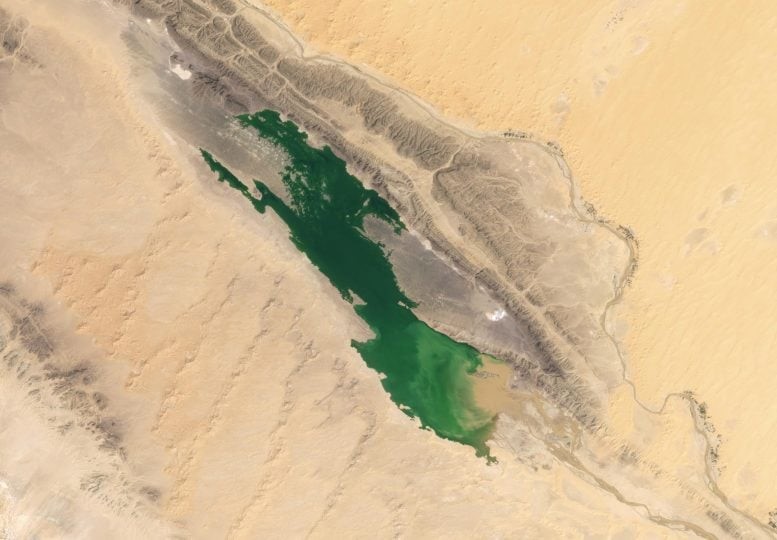New Research Revises Sahara’s Climate History Through a Disappearing Lake
New research finds that extreme Atlantic-driven rainfall is the primary cause of modern lake-filling events in the northwestern Sahara. The study challenges previous climate assumptions, showing that only the most intense and prolonged storms create these rare lakes. Findings suggest that increasing rainfall intensity and frequency could significantly affect future water availability in the region.

Figure 1. Revisiting Sahara’s Climate History Through a Vanishing Lake.
Recently published in Hydrology and Earth System Sciences, the study was led by Joëlle Rieder at ETH Zurich under the supervision of Dr. Moshe Armon (Hebrew University) and Dr. Franziska Aemisegger (University of Bern), in collaboration with Dr. Elad Dente (University of Haifa). It explores the meteorological mechanisms behind the intermittent filling of a typically dry lake in the northwestern Sahara. By connecting present-day hydrological events with past climate patterns, the research provides valuable insights into how future climate change could influence water resources in arid regions. Figure 1 shows Revisiting Sahara’s Climate History Through a Vanishing Lake.
The Sahara Desert, one of the world's driest regions, was once much wetter. Prehistoric evidence of wetlands suggests past periods of increased moisture, but the sources of this water have long been debated. This study investigates the occasional filling of Sebkha El-Melah, a typically dry lake in western Algeria, revealing the extreme storm events necessary to sustain such water bodies.
Key Findings
- Rare Lake-Filling Events:Despite hundreds of intense rainstorms recorded between 2000 and 2021, only six led to substantial lake formation.
- Atlantic-Driven Precipitation: These events were fueled by moisture from the Atlantic Ocean, challenging previous assumptions that equatorial sources played a dominant role.
- Cyclone-Atmosphere Interaction: Extratropical cyclones near the North African Atlantic coast interact with upper-level atmospheric patterns, creating ideal conditions for heavy rainfall.
- Recycling-Domino Effect:Moisture is progressively transported and amplified over the Sahara, increasing the likelihood of lake-filling events.
- Stationary Weather Systems: The persistence of weather patterns—typically lasting around three days—is a key factor in sustaining these rare hydrological events.
This study challenges the long-held belief that prehistoric Saharan lakes were primarily filled by monsoonal rains from the south. Instead, it underscores the role of Atlantic-origin storms, which transport oceanic moisture deep into the desert, bypassing the Atlas Mountains. These findings refine our understanding of past climate conditions and improve predictions of future hydrological shifts in arid environments.
Moreover, the research suggests that global warming could not only increase rainfall but also intensify extreme storm events, potentially leading to more frequent lake formations in the Sahara. This shift could have profound impacts on regional water availability, ecosystems, and human settlements.
By combining climate science, meteorology, remote sensing, and hydrology, this study bridges a critical knowledge gap, offering a foundational framework for future research on Saharan climate dynamics and water resources.
The headline "New Research Revises Sahara’s Climate History Through a Disappearing Lake" refers to a study that reshapes our understanding of how the Sahara's climate has changed over time by examining the intermittent filling and drying of a typically dry lake.
The research focuses on Sebkha El-Melah, a lake in western Algeria that occasionally fills with water after extreme rainstorms. Traditionally, scientists believed that prehistoric lakes in the Sahara were primarily fed by monsoonal rains from the south. However, this study challenges that view, showing that Atlantic-origin storms play a crucial role in bringing moisture to the region.
By analyzing modern lake-filling events, researchers have uncovered key meteorological mechanisms, such as how extratropical cyclones and atmospheric circulation patterns contribute to extreme rainfall. These insights not only revise past climate theories but also suggest that future climate change—with its projected increase in extreme weather—could reshape water availability in the Sahara.
In essence, the study uses a disappearing (or intermittently appearing) lake as a natural archive to better understand past, present, and future climate patterns in the Sahara Desert.
Source: SciTECHDaily
Cite this article:
Priyadharshini S (2025),”New Research Revises Sahara’s Climate History Through a Disappearing Lake", AnaTechmaz, pp.1111

